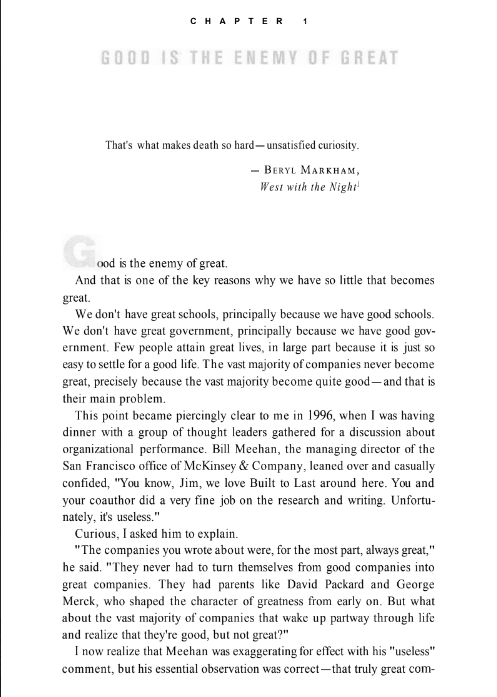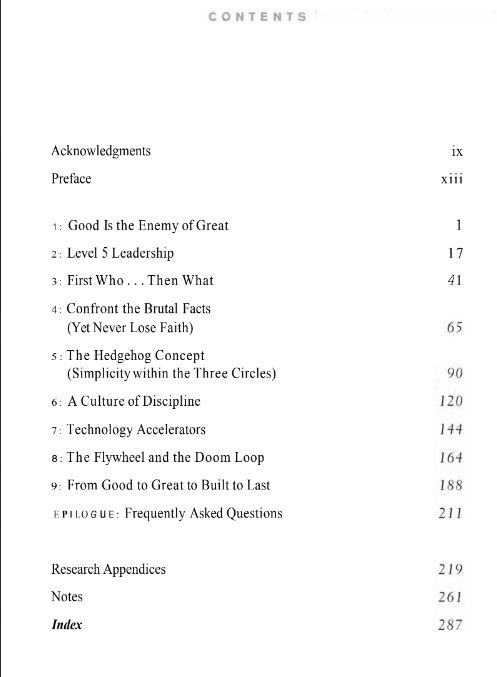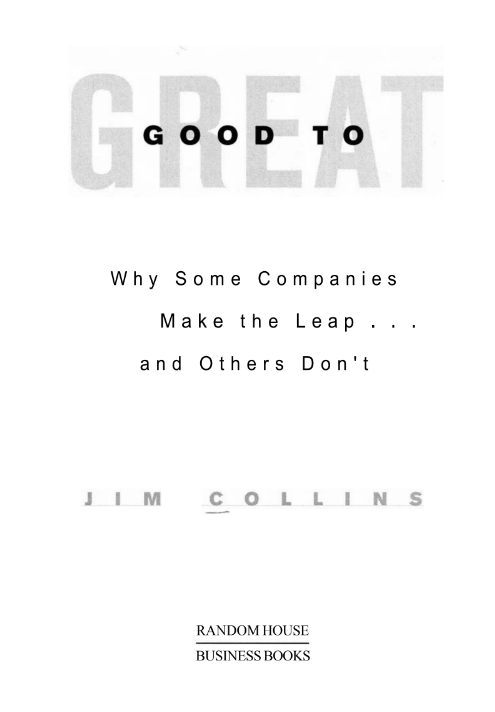


Five years after that fateful dinner we can now say, without question, that good to great does happen, and we’ve learned much about the underlying variables that make it happen. Inspired by Bill Meehan’s challenge, my research team and I embarked on a five-year research effort, a journey to explore the inner workings of good to great. To quickly grasp the concept of the project, look at the chart on page 2.” In essence, we identified companies that made the leap from good results to great results and sustained those results for at least fifteen years. We compared these companies to a carefully selected control group of comparison companies that failed to make the leap, or if they did, failed to sustain it. We then compared the good-to-great companies to the comparison companies to discover the essential and distinguishing factors at work.
The good-to-great examples that made the final cut into the study attained extraordinary results, averaging cumulative stock returns 6.9 times the general market in the fifteen years following their transition points. To put that in perspective, General Electric (considered by many to be the best-led company in America at the end of the twentieth century) outperformed the market by 2.8 times over the fifteen years 1985 to 2000. Furthermore, if you invested $1 in a mutual fund of the good-to-great companies in 1965, holding each company at the general market rate until the date of transition, and simultaneously invested $1 in a general market stock fund, your $1 in the good-to-great fund taken out on January 1, 2000, would have multiplied 471 times, compared to a 56 fold increase in the market.
We then turned our attention to a deep analysis of each case. We collected all articles published on the twenty-eight companies, dating back fifty years or more. We systematically coded all the material into categories, such as strategy, technology, leadership, and so forth. Then we interviewed most of the good-to-great executives who held key positions of responsibility during the transition era. We also initiated a wide range of qualitative and quantitative analyses, looking at everything from acquisitions to executive compensation, from business strategy to corporate culture, from layoffs to leadership style, from financial ratios to management turnover. When all was said and done, the total project consumed 10.5 people years of effort. We read and systematically coded nearly 6,000 articles, generated more than 2,000 pages of interview transcripts, and created 384 million bytes of computer data. (See Appendix 1 .D for a detailed list of all our analyses and activities.) We came to think of our research effort as akin to looking inside a black box. Each step along the way was like installing another lightbulb to shed light on the inner workings of the good-to-great process.
With data in hand, we began a series of weekly research-team debates. For each of the twenty-eight companies, members of the research team and I would systematically read all the articles, analyses, interviews, and the research coding. I would make a presentation to the team on that specific company, drawing potential conclusions and asking questions. Then we would debate, disagree, pound on tables, raise our voices, pause and lo lim Collins reflect, debate some more, pause and think, discuss, resolve, question, and debate yet again about “what it all means.”
The Flywheel and the Doom Loop. Those who launch revolutions, dra- matic change programs, and wrenching restructurings will almost certainly fail to make the leap from good to great. No matter how dramatic the end result, the good-to-great transformations never happened in one fell swoop. There was no single defining action, no grand program, no one killer innovation, no solitary lucky break, no miracle moment. Rather, the process resembled relentlessly pushing a giant heavy flywheel in one direction, turn upon turn, building momentum until a point of breakthrough, and beyond.
From Good to Great to Built to Last. In an ironic twist, I now see Good to rc 8 >x?-I” ‘preat not as a sequel — to Built to Last, but as more of a pgquel. This book is about how to turn a good organization into one that produces sustained great results. Built to Last is about how you take a company with great results and turn it into an enduring great company of iconic stature.
To make that final shift requires core values and a purpose beyond just making money combined with the key dynamic of preserve the core 1 stimulate progress. Yes, the world is changing, and will continue to do so. But that does not mean we should stop the search for timeless principles. Think of it this way: While the practices of engineering continually evolve and change, the laws of physics remain relatively fixed. I like to think of our work as a search for timeless principles-the enduring physics of great organizations-that will remain true and relevant no matter how the world changes around us.
Yes, the specific application will change (the engineering), but certain immutable laws of organized human performance (the physics) will endure. The truth is, there’s nothing new about being in a new economy. Those who faced the invention of electricity, the telephone, the automobile, the radio, or the transistor-did they feel it was any less of a new economy than we feel today? And in each rendition of the new economy, the best leaders have adhered to certain basic principles, with rigor and discipline.


